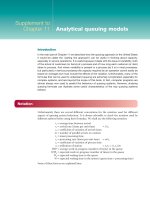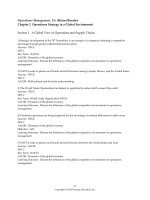Operations management heizer 6e ch06
Bạn đang xem bản rút gọn của tài liệu. Xem và tải ngay bản đầy đủ của tài liệu tại đây (2.23 MB, 72 trang )
Operations
Management
Chapter 6 –
Managing Quality
PowerPoint presentation to accompany
Heizer/Render
Principles of Operations Management, 6e
Operations Management, 8e
© 2006
Prentice
Hall, Inc. Hall, Inc.
©
2006
Prentice
6–1
Outline
Global Company Profile: Arnold
Palmer Hospital
Quality And Strategy
Defining Quality
Implications of Quality
Malcolm Baldrige National Quality
Award
Cost of Quality (COQ)
© 2006 Prentice Hall, Inc.
6–2
Outline – Continued
Ethics and Quality Management
International Quality Standards
ISO 9000
ISO14000
© 2006 Prentice Hall, Inc.
6–3
Outline – Continued
Total Quality Management
Continuous Improvement
Six Sigma
Employee Empowerment
Benchmarking
Just-in-Time (JIT)
Taguchi Concepts
Knowledge of TQM Tools
© 2006 Prentice Hall, Inc.
6–4
Outline – Continued
Tools Of TQM
Check Sheets
Scatter Diagrams
Cause-and-Effect Diagram
Pareto Charts
Flow Charts
Histograms
Statistical Process Control (SPC)
© 2006 Prentice Hall, Inc.
6–5
Outline – Continued
The Role Of Inspection
When and Where to Inspect
Source Inspection
Service Industry Inspection
Inspection of Attributes versus
Variables
TQM In Services
© 2006 Prentice Hall, Inc.
6–6
Learning Objectives
When you complete this chapter, you
should be able to:
Identify or Define:
Quality
Malcolm Baldrige National Quality
Award
ISO International Quality Standards
Taguchi Concepts
© 2006 Prentice Hall, Inc.
6–7
Learning Objectives
When you complete this chapter, you
should be able to:
Explain:
Why quality is important
Total Quality Management (TQM)
Seven tools of TQM
Quality robust products
Deming, Juran, Feigenbaum, and
Crosby’s ideas
© 2006 Prentice Hall, Inc.
6–8
Managing Quality Provides a
Competitive Advantage
Arnold Palmer Hospital
Deliver over 10,000 babies annually
Virtually every type of quality tool is
employed
Continuous improvement
Employee empowerment
Benchmarking
Just-in-time
Quality tools
© 2006 Prentice Hall, Inc.
6–9
Quality and Strategy
Managing quality supports
differentiation, low cost, and
response strategies
Quality helps firms increase sales
and reduce costs
Building a quality organization is a
demanding task
© 2006 Prentice Hall, Inc.
6 – 10
Ways Quality Improves
Productivity
Sales Gains
Improved response
Higher Prices
Improved
Quality
Improved reputation
Reduced Costs
Increased
Profits
Increased productivity
Lower rework and scrap costs
Lower warranty costs
© 2006 Prentice Hall, Inc.
Figure 6.1
6 – 11
The Flow of Activities
Organizational Practices
Leadership, Mission statement, Effective operating
procedures, Staff support, Training
Yields: What is important and what is to be accomplished
Quality Principles
Customer focus, Continuous improvement, Benchmarking,
Just-in-time, Tools of TQM
Yields: How to do what is important and to be
accomplished
Employee Fulfillment
Empowerment, Organizational commitment
Yields: Employee attitudes that can accomplish
what is important
Figure 6.2
© 2006 Prentice Hall, Inc.
Customer Satisfaction
Winning orders, Repeat customers
Yields: An effective organization with
a competitive advantage
6 – 12
Defining Quality
The totality of features and
characteristics of a product or
service that bears on its ability to
satisfy stated or implied needs
American Society for Quality
© 2006 Prentice Hall, Inc.
6 – 13
Different Views
User-based – better performance,
more features
Manufacturing-based –
conformance to standards,
making it right the first time
Product-based – specific and
measurable attributes of the
product
© 2006 Prentice Hall, Inc.
6 – 14
Implications of Quality
1. Company reputation
Perception of new products
Employment practices
Supplier relations
2. Product liability
Reduce risk
3. Global implications
Improved ability to compete
© 2006 Prentice Hall, Inc.
6 – 15
Key Dimensions of Quality
Performance
Durability
Features
Serviceability
Reliability
Aesthetics
Conformance
Perceived quality
Value
© 2006 Prentice Hall, Inc.
6 – 16
Malcom Baldrige National
Quality Award
Established in 1988 by the U.S.
government
Designed to promote TQM practices
Recent winners
The Bama Companies, Kenneth W.
Monfort College of Business,
Caterpillar Financial Services, Baptist
Hospital, Clarke American Checks,
Los Alamos National Bank
© 2006 Prentice Hall, Inc.
6 – 17
Baldrige Criteria
Applicants are evaluated on:
Categories
Leadership
Strategic Planning
Customer & Market Focus
Information & Analysis
Human Resource Focus
Process Management
Organizational Results
© 2006 Prentice Hall, Inc.
Points
120
85
85
90
85
85
450
6 – 18
Takumi
A Japanese character
that symbolizes a
broader dimension
than quality, a deeper
process than
education, and a more
perfect method than
persistence
© 2006 Prentice Hall, Inc.
6 – 19
Costs of Quality
Prevention costs - reducing the
potential for defects
Appraisal costs - evaluating
products, parts, and services
Internal failure - producing defective
parts or service before delivery
External costs - defects discovered
after delivery
© 2006 Prentice Hall, Inc.
6 – 20
Costs of Quality
Total
Cost
Total Cost
External Failure
Internal Failure
Prevention
Appraisal
Quality Improvement
© 2006 Prentice Hall, Inc.
6 – 21
International Quality
Standards
Industrial Standard Z8101-1981 (Japan)
Specification for TQM
ISO 9000 series (Europe/EC)
Common quality standards for products
sold in Europe (even if made in U.S.)
2000 update places greater emphasis on
leadership and customer satisfaction
ISO 14000 series (Europe/EC)
© 2006 Prentice Hall, Inc.
6 – 22
ISO 14000
Environmental Standard
Core Elements:
Environmental management
Auditing
Performance evaluation
Labeling
Life-cycle assessment
© 2006 Prentice Hall, Inc.
6 – 23
Leaders in Quality
W. Edwards Deming
14 Points for
Management
Joseph M. Juran
Top management
commitment,
fitness for use
Armand Feigenbaum
Total Quality
Control
Philip B. Crosby
Quality is Free
© 2006 Prentice Hall, Inc.
6 – 24
Ethics and Quality
Management
Operations managers must
deliver healthy, safe, quality
products and services
Poor quality risks injuries,
lawsuits, recalls, and regulation
Organizations are judged by
how they respond to problems
© 2006 Prentice Hall, Inc.
6 – 25









